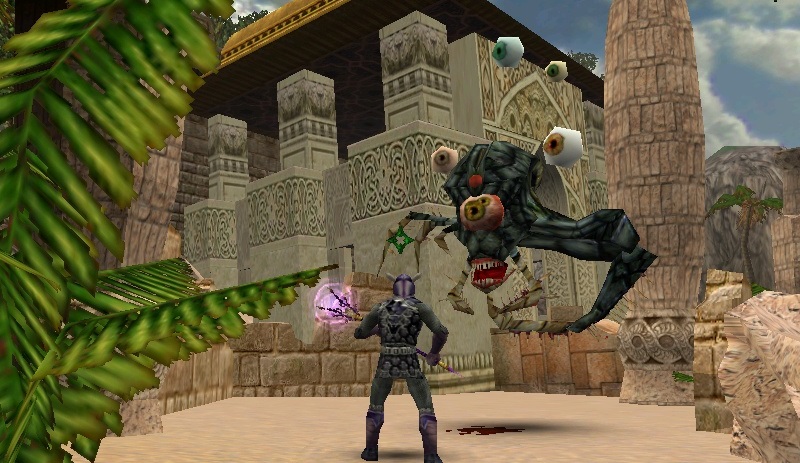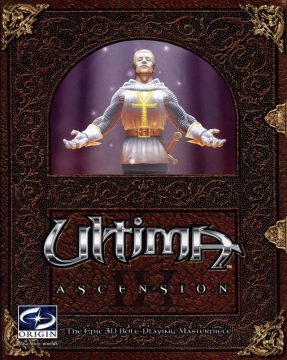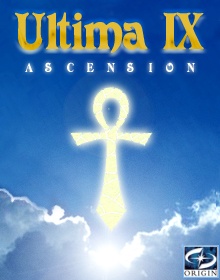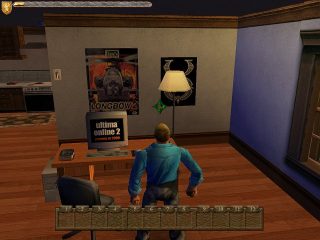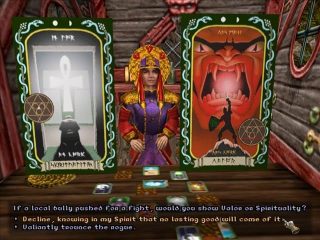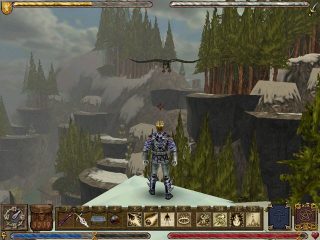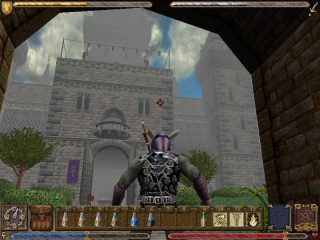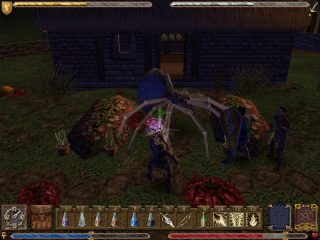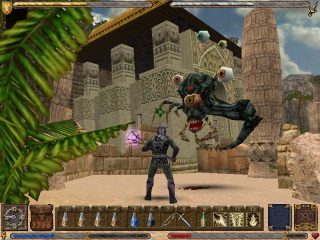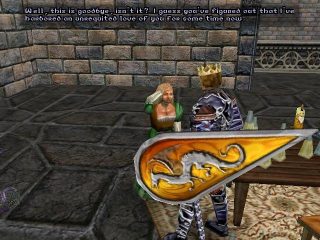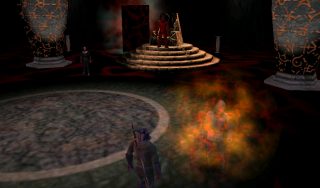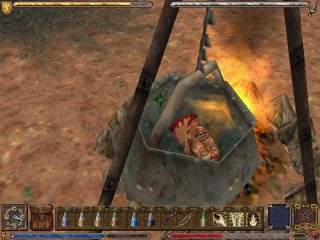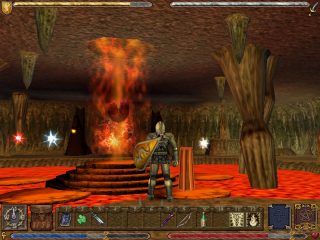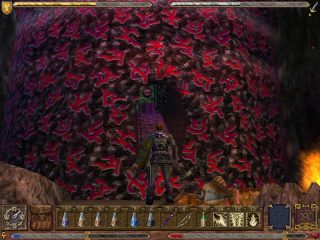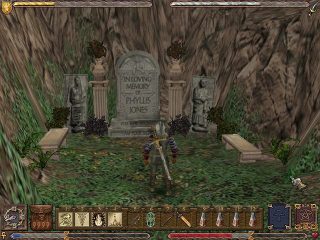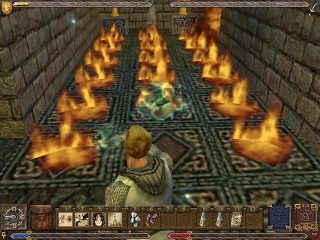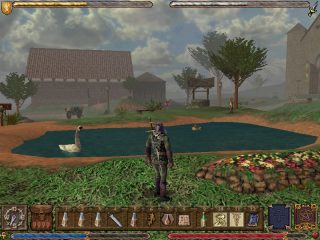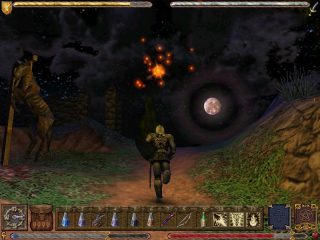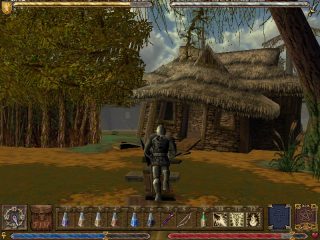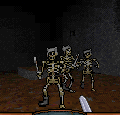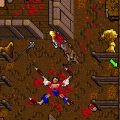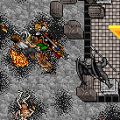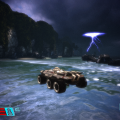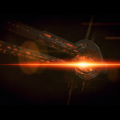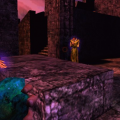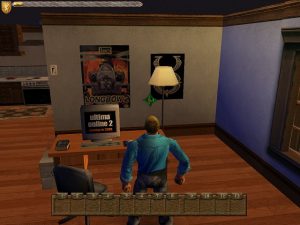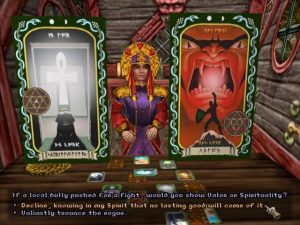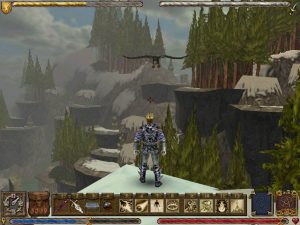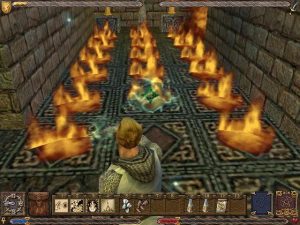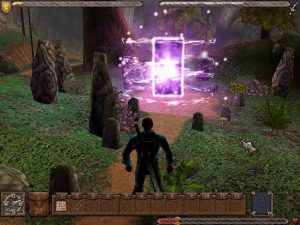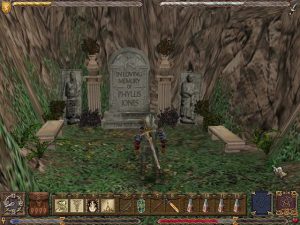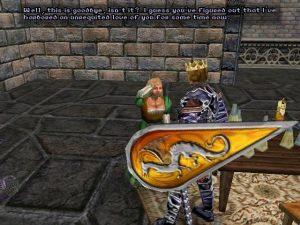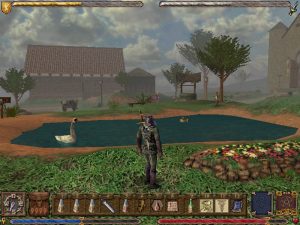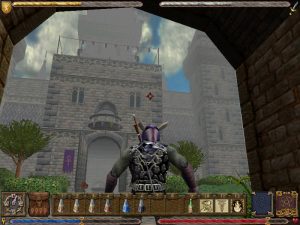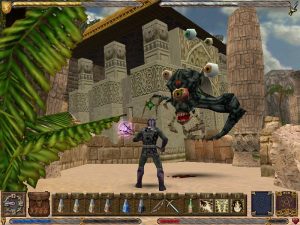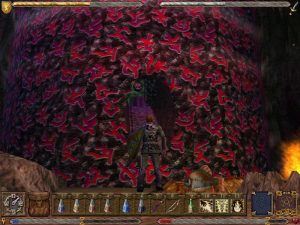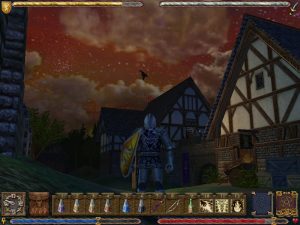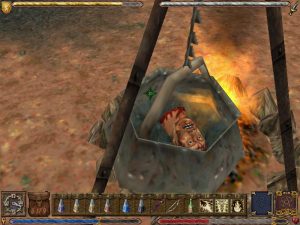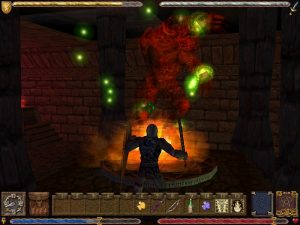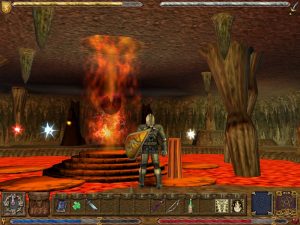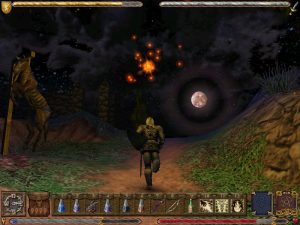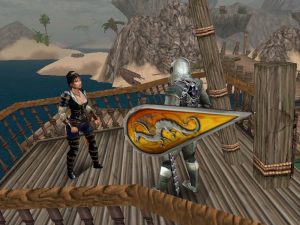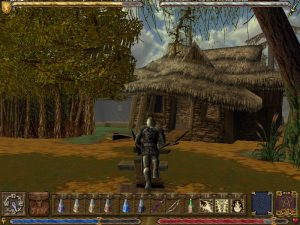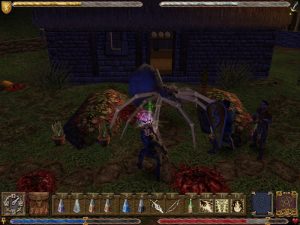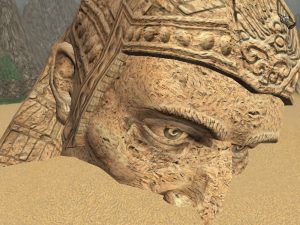- Ultima (Series Introduction)
- Akalabeth
- Ultima I: First Age Of Darkness
- Ultima II: Revenge of the Enchantress
- Ultima III: Exodus
- Ultima IV: Quest Of The Avatar
- Ultima V: Warriors of Destiny
- Ultima VII: The Black Gate
- Ultima VI: The False Prophet
- Ultima VII Part 2: Serpent Isle
- Ultima VIII: Pagan
- Ultima Underworld: The Stygian Abyss
- Ultima Underworld II: Labyrinth of Worlds
- Arx Fatalis
- Worlds of Ultima: The Savage Empire
- Ultima Worlds of Adventure 2: Martian Dreams
- Ultima IX: Ascension
- Lord of Ultima
- Ultima Online
- Ultima: Escape from Mt. Drash
- Ultima: Miscellaneous
- Richard Garriott (Interview)
Yet again, you as the Avatar are woken from your slumber in your boring, normal bed in boring, normal Earth by Britannia calling you. It is Hawkwind, Lord British’s royal seer, speaking across worlds to beg for your help in defeating the Guardian, who has in your absence finally reached Britannia. With the help of the traitor Blackthorn who has escaped exile, the Guardian has invaded, raising great black columns that gradually corrupt the physical and spiritual essence of the land, as well as drawing Britannia’s two moons ever closer to an apocalyptic collision with the world. The worst part? The Guardian is powering these columns using the Runes of Virtue that allowed you to become an Avatar so long ago, perverting every ideal Britannia holds dear. This is the final battle, Avatar. One or the other of you won’t be walking away.
Hold on a second, attentive players ask. Why is the game starting on Earth? Didn’t the destruction of the Black Gate in Ultima VII mean you could never go home again? Didn’t the rebuilding of it in Pagan bring you from there back to Britannia? There’s a reason for that.
Ultima IX: Ascension is the final game in the Guardian Saga trilogy, the conclusion of the long story that began in 1981, the last single-player game Origin Systems would ever release, and the conclusion of a rich, complex twenty-year tale. The gap between Pagan and Ascension is the longest between entries in the series, and was the first game released originally for Microsoft Windows. With the colossal advances in computer hardware and software tools since 1994, Ascension is also the first game in the series to be rendered in true 3D, making it the most technologically advanced Ultima released. And, on top of all that, it inspires the most hate. Hate, hate, hate. Frothing, raging hate that makes the hate RPG fans at RPGCodex have for any game that dares to call itself an RPG look like light Sunday tea with the neighbors. You may think gamers were a bit disappointed by Pagan, but that’s peanuts to Ascension, listen.
Ultima IX is an awful game. It was barely playable on release and even years later, with faster computers and a multitude of unofficial fan patches, it’s barely more stable. Two years prior to Ascension’s release, id Software’s Quake II had dramatically changed the computer game industry with its focus on true 3D hardware-accelerated graphics, kicking off a craze for 3D accelerator cards that could handle these new games. Several different APIs (a rule set for how to draw graphics) were competing, with 3Dfx’s Glide API and Voodoo cards at the top of the heap, and the alternative Direct3D and OpenGL formats trailing. Ultima IX only really worked well on 3Dfx’s hardware, presumably due to a lack of time to test for the less popular APIs, which backfired spectacularly when 3Dfx’s business fortunes dropped out from under them in 1999 in one of the most significant turnarounds in computer game history. Basically, nobody could play this game, because Voodoo graphics cards had dropped significantly in popularity the year Ascension came out.
It’s still a devil to even get it working; the article author suffered numerous crashes before even getting to Britannia, and as a result nearly all of the screenshots for this segment of the article are stock shots or shots taken by others and used here with their permission. Contemporary reviews of the game complain about corrupted saves, crashes during saving, crashes to desktop given with no error messages or warning, memory leaks that make the game run slower if it’s been open for a while. Ascension has literally hundreds of documented bugs; it’s just an inelegant-coded mess of a program.
What about the game itself? Quite fun, actually. Ascension plays rather like previous games control-wise and the interface seems like a logically upgraded version of the one in Ultima VII. A backpack stores items again, but the game adds a toolbelt, giving the player slots at the bottom of the screen to quickly access often-used items. The world may be in 3D instead of overhead 2D, but the mouse-based control is still smooth and intuitive and switches between guiding movement with the mouse and the old Ultima VII style of interacting with objects, a refreshing return to form after the action-y experiment of Pagan. The new 3D graphics are quite beautiful as well. While Ascension is no Unreal Tournament, it compares very favorably to other contemporary 3D games of 1999, and after finally getting the game working, you’re treated to a cosmetically lovely Britannia that looks and feels great as you run around seeing the sights and swinging your sword with wild abandon.
At some point the Ultima series evolved from RPG adventures that inspired the Zelda and Ys style games to straight RPGs, and then gradually back to action-adventure games; Ascension solidly belongs to the latter, and while you start the game with no magic and only a few moves, after completing a few dungeons and visited a few trainers you’ll have acquired an impressive spellbook and a variety of different forms of attacks for different weapons that make the game’s real-time combat seem fresh and interesting. Your starting attributes are based on the class you chose via the classic tarot-reading introduction, and the classes are back to the eight from Quest of the Avatar, not seen as a game mechanic since that game. Even though the enemy AI is dumb as it gets, it’s still a vast improvement over the dull click-fest that is Pagan’s combat. The jumping and climbing of Pagan return, but are less irritating to control, and to the mix is added the glorious addition of swimming (no instant Avatar melting puddles this time!).
During all this, too, you’re treated to a fantastic soundtrack. George Oldziey, who previously scored Origin’s cinematic flight sims Wing Commander III and Wing Commander IV and has given a few classic themes (notably the very british-sounding Rule Britannia theme) the symphonic treatment, as well as composing a series of leitmotif themes for each of the principles and virtues, mixing them according to the area you’re in (Moonglow, town of Honesty which forms the principle of Truth, mixes the themes for both to create its theme). It’s both interesting and a good listen. The worst that can be said about the gameplay is that it’s just too easy; without a monster getting a lucky shot on you, you aren’t going to die very often, if at all.
Didn’t we just get through saying Ascension is an awful game? It sounds like it’d actually be pretty good if the innumerable bugs were ignored or fixed. Sure, the dungeons are mechanism-based and play more like something out of the contemporary The Legend of Zelda: Ocarina of Time or Legacy of Kain: Soul Reaver than an Ultima, but that’s a matter of taste, the low difficulty isn’t necessarily a deal-breaker, and the rest of the game has a great presentation.
The bugs, see, aren’t why Ultima fans loathe Ascension with a molten passion. It’s what the game does to the lore. Pagan was often annoying to actually play and rushed to release but at least had an interesting, detailed and complex world that suggested deeper lore than was actually there, the hallmark of good worldbuilding. The plot and dialogue of Ultima IX: Ascension are simply insulting, stomping all over nearly the entirety of the rich canon that has been building for twenty years. Retcons are a hallmark of Ultima, certainly, as each game tended to retcon elements of previous in order to create a larger and consistent whole. The story changes in Ascension, however, make things worse instead of richer. Massive plot holes, a near-total disrespect for continuity, exceedingly poor writing, missing details and a disregard for the core elements of Ultima are legion. A foe whose death was a major part of the plot of Pagan returns inexplicably alive, the Avatar has somehow returned to Earth when he was supposed to never be able to again after the events of The Black Gate; items long destroyed have someone wound up in the Britannia Museum displacing items there since Ultima VI; main characters vanish without a mention, most notably long-time companion Sentri. An entire article could be filled with the game’s ignorance of its predecessors (and has been; link to Hacki Dragon’s website below).
If you thought Serpent Isle was a bit less open than previous games, look at Ascension. The story is extremely linear, with no sideplots and little room to go off and do your own thing. You can certainly go take a peek, but there’s nothing there other than those lovely graphics. The game sequence consists of town, dungeon, town, dungeon, over and over until the end. Britannia is populated entirely by one-liner NPCs with no real dialogue or depth, not even NPC activity schedules like Ultima has had since Warriors of Destiny. The world is the opposite of dynamic and lively. They’re background fuzz, with only a tiny handful of even the dull ‘fetch this’ or ‘slay that’ sort of quest present to break it up. Old companions like Shamino and Iolo act like fanfiction extrapolations of themselves; there is no camaraderie with the Avatar, even when you save them from the fate the Guardian had in store. It’s jarring to see the Avatar and (the inexplicably much-aged) Lord British, who have long had an easy, informal relationship, suddenly striking up the strict honorifics and protocol. As for the Guardian himself, the promised final battle with him arrives, but his revealed ‘true’ nature seems to contradict the spirit of the Britannian Virtues and the entire ethical aspect of Ultima as well as the purpose of the Avatar.
For people that have kept up with Ultima since the early ’80s, Ascension is simply tragic, a rushed piece of product rather than the denouement they’ve waited for. Interacting with Ultima fandom gives you the impression that a large chunk of it considers the series to have ended with Pagan, and that Ascension is simply not canon. This is all a horrible shame, because all the ingredients were there for an absolutely stunning game to make its mark in industry history, if only the development team had more time to fix bugs and a better plot to incorporate.
There are, of course, reasons why Ascension became what it is. It’s not simply that Ascension had a troubled development history. Ultima VIII: Pagan had a troubled development history. Ultima IX: Ascension had the ninth circle of development hell.
The story of the game’s development is long and twisted, and frankly makes for more interesting reading than the final product does. Planning for the game started as early as 1994, and went through various incarnations of both engine and game plot. The earliest idea seemed to be the use of the Crusader engine (a modified Pagan engine used for Origin’s Crusader series) to create a similarly arcade-style Ultima but with a world that played more like the Britannia of Ultima IV and V. This changed when Pagan received largely negative fan feedback, causing the idea for Ascension to change dramatically (Garriott mentions in Fans.txt, included with Pagan’s patch, that feedback has changed the idea for Ultima IX drastically back to classic Britannian role playing). A childhood friend of Garriott’s named Bob White was hired as the game’s development lead after that, and under White’s direction the game adopted the current ‘Guardian invades Britannia and Avatar engages him in final showdown’ plot outline, while also continuing the Ultima tradition of ordering a totally new engine.
The new Ultima IX engine was isometric 3-D, rather like Pagan’s viewpoint except rotatable and with fully 3D-rendered models instead of sprites (it appears to have been similar to the cameras used in many real-time strategy games in the 2000s, like Relic’s Dawn of War series), and according to a Richard Garriott review for german magazine PC Player, the game would have used a skill tree system of development for characters like in Ultima Underworld. Unlike the released game, this version would have been a return to player parties; having Companions being one of Pagan’s most missed features. The new plot, generally referred to by fans as the Bob White plot (though it was really written by Richard Garriott and several co-authors, with White only giving it some spit and shine), followed from Pagan with the Avatar returning to Britannia, and was essentially worked out in full by mid-1996; the ‘bob white’ plot for the game is available in full for anybody that cares to read it, and is rather more detailed than what made it into the final game. Progress for Ultima IX was going at a good clip until it suffered the setback which undeniably killed this version of the game for good: Origin’s own unexpected success with Ultima Online.
Reportedly, the Bob White version of Ultima IX had actually reached an early alpha state (incomplete but playable) when the response for Ultima Online‘s first tests had proven unexpectedly positive. Electronic Arts chose to take advantage of what looked like a massive hit in the making and ordered the entire Ascension team reassigned to Ultima Online. UO was released less than a year later to massive history-making critical and player acclaim, but that’s another story. By the time the rest of the Ascension team was back at work on it – the people that chose to return, since many did not – the game was looking distinctly dated and developer morale was at an all-time low.
Enter id Software’s Quake II. Even before it was actually released in December of 1997, Quake II‘s hardware-accelerated 3D graphics caused a massive stir in the game industry, directly or indirectly sparking interest in the power of the new hardware-accelerated 3D graphics technology. Mike McShaffrey, one of the Ascension devs, managed to rejuvenate interest in the project by showing the rest of the team a version of the game running on 3Dfx’s technology. The decision was made at Origin to overhaul the existing game to jump on this new graphics technology, and work on the game began anew, this time with a third-person action-platformer viewpoint for the camera in a fully 3D-modelled world.
The project lead for this version of the game was Edward Del Castillo, who previously produced Westwood Studios’ Command & Conquer and Red Alert games. Under Castillo, the game’s plot remained essentially the same as it had been under Bob White’s leadership, but the game went through mechanical changes, some to accommodate the increased workload this new game would have on computers of the time and simplify production (it is at this point that player parties were removed as a game feature; as well, the option to be a female avatar or choose an appearance was dropped because it complicated the game’s prerendered cutscenes). Ed Castillo had a somewhat different design philosophy than Bob White – under his leadership, the game became much more action-oriented and fast-paced. During this time, a teaser trailer for the game was released showing many of the game’s cutscenes as well as video of the Avatar in combat, and this was the first glimpse of what the final product would eventually look like. (This is referred to by Ultima fans as the ‘heavy metal’ trailer due to the jarringly rock & roll music used, and is generally attributed to Ed Castillo’s tastes and design philosophy).
For the second time the game was approaching completion, which per the rules of dramatic narrative meant it was time for disaster to strike again. Two of the key designers for Origin left the company on angry terms, leaving for former Origin and id Software programmer John Romero’s start-up Ion Storm; Bob White followed them soon after, though he left Origin on rather more amicable terms. All three had creative differences with project leader Castillo’s vision of the game. Little work was done on Ascension after this, and a month after White left, Castillo resigned due to a personality conflict with Richard Garriott. Ascension couldn’t get a break; at least three times now it had been gutted right after making serious progress.
Richard Garriott at this point took direct control of the Ascension project. By now also, parent company Electronic Arts had become somewhat exasperated with the whole bloody mess and gave Origin a deadline for finishing Ultima IX: Christmas 1999, or else. This was not nearly enough time to implement the ambitious original script and all the features the developers wanted to incorporate in the final game. A period of frantic salvage work began: seven-day weeks, fifteen-hour days, developer nervous breakdowns, using every possible minute to slash Britannia’s size, rewrite the plot into something more simplistic, and cut down the game’s scale all so it had a chance of getting finished in time for the deadline. It’s at this point where even a semblance of companions, most of the sidequests and all of the subplots, and NPC schedules were cut from the game, and it barely made it over the finish line, having won the race but lost its head and most of its limbs. The cut-up, unfinished and untested mess that EA published is the Ascension we have now.
The original version of Ascension is one of the most significant “lost games” in computer gaming, the CRPG equivalent of the Beach Boys’ “Smile” or Harlan Ellison’s third Dangerous Visions, and in the same league as the long-lost Black Isle Fallout 3, never-released Journeyman Project IV and canned Warcraft: Lord of the Clans. We can safely assume that the code and builds of the original isometric Bob White Ultima IX, or the in-progress Ed Castillo Ultima: Ascension are lost forever. Amusing, many elements of the original plot actually remain in the finished game, unexplained. Lord British’s advanced age, normally unreachable but fully detailed areas of the dungeon Stonegate, a mysterious mirror in Lord British’s bedroom, and many cutscenes which were re-purposed awkwardly when the events they were created for were removed.
Ultima IX: Ascension was only released for Microsoft Windows and no other official ports exist. The game was the subject of a major marketing campaign by Electronic Arts, and was released in at least two special editions. Two years prior to the game’s official release, Electronic Arts published an Ultima Collection disk, first under Origin’s name and later under their EA Gold Classics label, containing the DOS versions of Ultimas I through VIII, including Serpent Isle, both Ultima VII expansions, and a brand-new DOS port of Akalabeth, now officially titled Ultima 0. The package also included every piece of documentation for the games in multiple faithfully-rendered electronic formats on the CD, as well as a series of short interviews with Richard Garriott about himself, the previous games, and the upcoming Ultima IX. (the collection notably does not include the Underworld or Worlds of Adventure titles, which disappointed basically everyone).
As for Ascension itself, when it finally appeared in late 1999, the regular release contained appropriate feelies: the traditional cloth map, eight tarot cards representing the Virtues, two detailed manuals written like in-universe books and what is undeniably a very impressive-feeling box designed to look like an ornate leather-bound tome. The special Dragon Edition of the game, named for the Ultima Dragons internet fan club, is even more impressive, being a larger box containing all of that as well as an Ankh pendant, a Tapestry of Ages poster depicting the entire in-universe history of the Avatar’s quests, a soundtrack CD containing the game’s impressive score and a copy of the Ultima Collection disc. In mid-2000 the game received a second special release as the Ultima: Best of Both Worlds edition, containing Ascension packaged together with the Renaissance expansion for Ultima Online, though none of the special trinkets from Ascension‘s first releases were included.
Ascension has been subject to a number of fan patches and upgrades, most notably Grandor Dragon and Maido Dragon’s Dialogue patch, which is essentially a complete rewrite of the game’s written script to take into account earlier games, patch plot holes, and explain things left without official explanation (poor Sentri!). The Dialogue patch seems to be born out of Hacki Dragon’s Ultima IX nitpicks webpage, a well-frequented fansite where Ultima fans come together to celebrate Ultima by pointing out plot holes and inconsistencies. The Dialogue patch improves the experience of playing the game by several orders of magnitude, and all screenshots taken of Ascension for this article are shown with it. Other fan overhauls are included in the section on Ultima fan works.
It’s a sad thing that the Ultima ended this way. You can bet that Ultima’s dedicated fans will continue to improve the game, though; the entire original script is available to anyone, after all. Maybe one day Ascension will be the epic conclusion the series deserved.
Links:
Official website, archived on Wayback Machine.
Ultima: The Reconstruction, containing the last official Ascension patch (1.18f), the essential fan patch (1.19f), and the highly recommended Dialogue and Economy patches.
Collection of video interviews with Richard Garriott from the Ultima Collection, released to hype Ascension.
Overview of the cancelled original Ascension.
The treatment for the game’s original plot, courtesy of lead designer Bob White and the Origin Museum.
The treatment for the game’s script under Ed Castillo.
Possible ending cutscene for the Bob White plot.
Ed Castillo ‘Heavy Metal Ultima’ trailer.
Hacki Dragon’s Nitpicks, or how to properly enjoy Ascension.
Doug the Eagle Dragon’s Ultima IX humor page: bugs can be fun!
